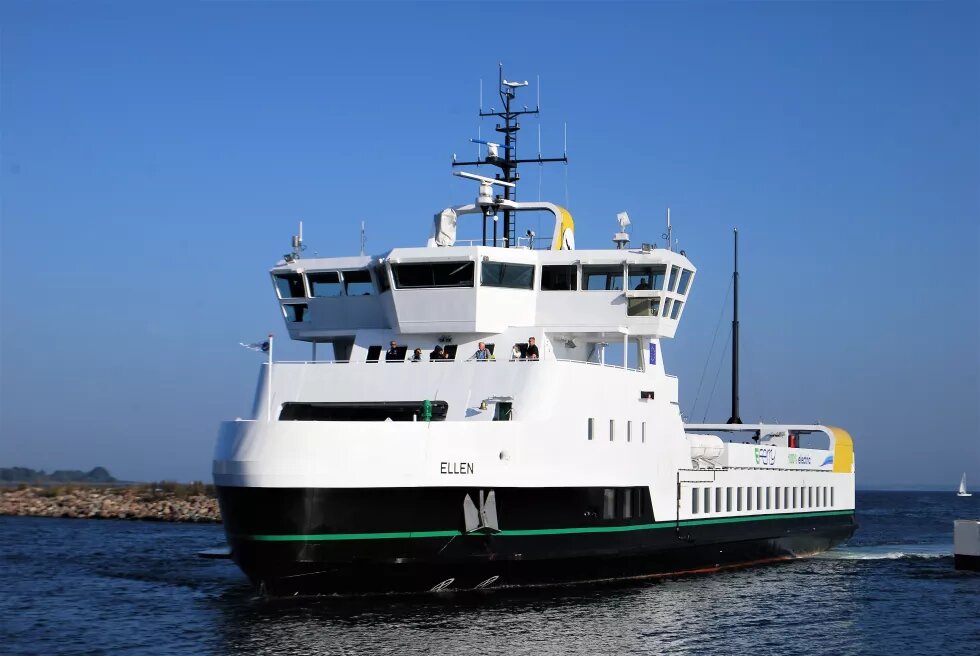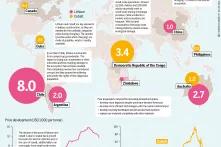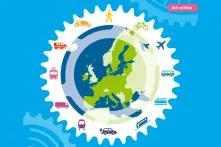Electrifying European transport is a clear-cut way to reduce greenhouse gas emissions. In Denmark, the pioneering electric car ferry “Ellen” connects the port of Fynshav and the island of Ærø. European Mobility Atlas 2021 Chief Executive Editor Philipp Cerny interviewed Halfdan Abrahamsen from the Municipality of Ærø’s Energy and Environment Office.

Philipp Cerny: Could you briefly introduce us to Æro and to E-Ferry Ellen?
Halfdan Abrahamsen: Ærø is a Danish island with 6,000 inhabitants, located in the western Baltic Sea, south of the island of Funen. Ærø has been a pioneer in different energy-related projects since the beginning of the 1980s. With recent energy crises in mind, a group of locals got interested in the idea of becoming energy independent with renewable energy, and they created a cooperative to fund the construction of what would become Denmark's largest wind park in 1985. Now we have large district heating plants based on solar arrays (at one point the town of Marstal had the largest in the world), and the old turbines have been upgraded to six 2-megawatt wind turbines financed with fixed-price shares. The most important aspect is that local residents own the energy production cooperatively, which has a big impact on the acceptance of the production sites. Effectively, this means that there have always been good attitudes towards green energy on the island. Politically, Ærø wants to be fossil fuel free by 2030 and CO2 neutral by 2025. Already today, a surplus of green electricity is produced on the island. The biggest challenge for the island's ambitions is the ferry fleet. The municipality operates four ferries, of which Ellen is the only electric one, so far.
Who came up with the idea to purchase an all-electric ferry?
The idea of a fully electric ferry came from a group of local maritime and battery experts and enthusiasts. Ærø still has its own shipyard, naval engineers and the Marstal School of Navigation, and due to its green energy focus, also has several electric transport “activists”. Furthermore, local politicians see the benefits that come from the island's renewable energy projects, and just like other islanders, they see the concrete dangers connected to global warming, for instance rising sea levels. Nowadays, there is, of course, a certain pride that we are praised for being frontrunners. That is certainly a compliment that everybody enjoys hearing. However, Ellen was also an economic decision. With the surplus of electricity that we produce, we found out that it would be cheaper to operate an e-powered ferry. As a side effect, the island is now more self-reliant. Of course, this decision to build a fully electric ferry was not without risks. Ellen covers a distance that is seven times longer than any other fully electric ferry, and we sail 22 nautical miles between charges.
What else is special about Ellen?
Almost all electric ferries in the world still have an emergency generator on board. Ellen does not! Most of the hybrid electric ferries in operation are rebuilt diesel ferries. Ellen has been built from scratch, following the needs and particularities of a medium-range fully electric ferry. As I said, this obviously came with certain risks, since there were no other directly comparable builds to use as a blueprint. Ellen has a very different design compared to other typical ferries. On the outside, the main difference is that it is long and relatively narrow, to be able to “cut” through the water as efficiently as possible, just like a classic sailing ship. Moreover, there is an open car deck, to save weight. Inside, we also focused on saving as much energy as possible. The passenger deck is on the ground floor, close to the waterline, so we did not need to install an elevator. We also refrained from installing a deep fryer, gaming machines or other amenities that use a lot of energy. Essentially, the whole ferry is constructed to save energy.
Designing and building a new ferry must have been an expensive undertaking. How did you manage to finance Ellen?
The municipality applied for funding from the EU’s Horizon 2020 programme, which eventually covered more than half of the total costs of about 21.3 million euro. One of the conditions for EU financing was that the project would include a number of European partners; for instance, the batteries come from a German/Swiss battery manufacturer and the engines from a Finnish electric engine producer, which, by the way, was later bought by Danish Danfoss. Regarding the business case in general, it is essentially the same as when you buy an electric car. The purchase costs are higher, but the running costs are lower, and in the long run it is cheaper to operate an electric ferry. It needs to be said that we spent a lot of money on innovation and preliminary investigations, and building a new E-ferry today would be much cheaper than building the Ellen, perhaps just 15 per cent more than a diesel ferry with similar capability.
This sounds like a lengthy process. How long did it take altogether from the idea to the launch of the ferry?
In the early 2010s, the group behind the idea made various preliminary studies, funded by local and regional funds, and the municipality eventually got behind the idea, as a replacement for one of the aging ferries. In 2015, the partnership was in place, the funding from Horizon 2020 was secured and the agreement to build Ellen was signed. The ferry entered service in 2019, so we do consider this a relatively speedy process, despite the fact that there were some delays along the way. Building the Ellen required a lot of innovation.
Electric engines are not the only alternative to classic combustion engines, so have you considered other options?
Hydrogen, for instance, is in the spotlight at the moment. However, for us it was never an option. We have a surplus of green electricity. By transforming this surplus into hydrogen, we would have lost a lot of energy in the conversion process. That would have been a waste. More importantly, we think that it will still take quite some years before we see a sufficient supply of green hydrogen. So, as I always say at conferences, please consider going fully electric when possible, because the technology is available now, and because of energy efficiency. The energy efficiency from the transformer on land to Ellen's propellers is 85 per cent, which is extremely high. We lose very little energy through the chain and the systems. As a matter of fact, the CO2emissions connected to producing the batteries was gained back after just three months of operations with the Ellen.
Have you faced any difficulties convincing people of the concept of an all-electric ferry?
Our passengers are happy. No more rumbling diesel engines and no smog on the sun deck, so in general a much smoother, quieter and more pleasant trip. From an operator's perspective, we sail with a small crew on board. Because of the simplicity of the electric systems, we can sail without an engineer on board, which is quite unusual. This is, of course, not something that everybody appreciates, but it certainly helps the business case. We have experienced pushback from some quarters. The maritime world has many traditions, and obviously some people love the “good old” diesel engines, because they like the machines and they feel comfortable with what they know and what they are used to. Yet, the energy transitions also mean a transition in technology and required skills.
What are the biggest challenges that you have faced so far?
We have been so lucky to be able to build on the experience of other operators that run hybrid electric ferries. In Denmark, the Helsingør – Helsingborg line operates traditional ferries that are rebuilt with electric engines, and they were the pioneers here. From their experience we knew that recharging must work flawlessly and reliably under all conditions, so this was definitely a design challenge. Our charger, built by Mobimar, is placed on the ramp that is used to drive on and off the ferry, and this has worked perfectly because the weight of the ramp on the ferry deck locks the charger arm to the movements of the ferry in the water, meaning we do not experience disconnects. In addition, we found that it can be a challenge to keep all 840 batteries balanced. That means we want them to charge at the same rate and be used at the same rate. This requires specialised software and advanced battery and electrical systems. After some tweaking, the system is now functioning as desired.
Is there anything that you have learnt throughout the project that you would like to share with politicians and other ferry companies that might potentially invest in an electric ferry?
At a national level, politicians should have a strategy for electrifying ports. Ferry operators are used to ordering new ferries, but they are not used to ordering and building transformer stations on land. Without available electricity, operators will be more hesitant to go electric. Moreover, developing and using standardised solutions would make it easier to predict what works and what doesn't work. Developing new systems for every individual ferry creates unnecessary expenses and makes installations less flexible. Considering service levels, with our systems and operating strategy we manage three 22-nautical mile crossings with only 10-15 minutes of charging during reloading in the homeport. Then we have a single 45-minute midday break where the batteries are basically topped off. So, if the charger is fast and reliable, a high service level can be achieved, even on longer routes. We have a lot more energy on board than we need for a single crossing, because we only charge the ferry in the homeport, Søby on Ærø, and because we only take that one long break during midday. We found that it made more sense to carry many batteries than to build a charger in every port, because the land facilities needed for the charger are so expensive. This also means we have the required energy for emergency situations.
What challenges are you expecting to face in the future?
The most obvious thing is that batteries lose capacity over time. We expect Ellen to lose 20 per cent battery capacity in 10 years, and then they will have to replaced, otherwise we can't maintain our service level. Our business case includes two complete battery replacements during a 30-year life span. Of course, batteries with 80 per cent capacity are still a great resource. Perhaps we could use the old batteries for balancing the local grid when the wind is not blowing, but this is not something we have a practical solution for at this point. From an environmental viewpoint, we would like that battery manufacturers could give us assurance that they will be able to recycle the batteries at the end of their lives. However, with the current technology they have not been able to give this assurance.
Do you consider Ellen as a role model for other ferry routes?
Absolutely! Our studies have revealed that more than 900 ferry routes in Europe could be operated with a ferry like the Ellen. Just in Denmark alone, 75 per cent of the routes could be served by electric ferries! And that is with the current state of technology. I'm very happy to say that we have made our in-depth evaluation report available to the public, as it describes both the economic and environmental aspects of the E-ferry, and I hope that this will help others make the decision to go fully electric.
Thanks Halfdan for this interview!




